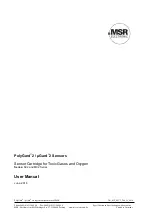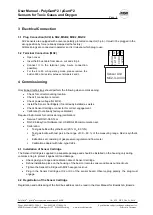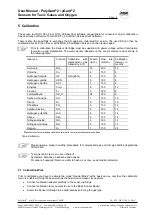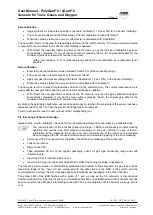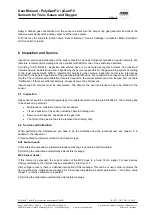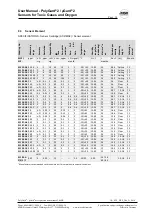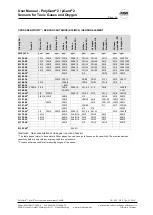
User Manual - PolyGard
®
2 / µGard
®
2
Sensors for Toxic Gases and Oxygen
Page
3
PolyGard
/ µGard
®
are registered trademarks of MSR
GA_SC2_MC2_Tox_D_0618
Phone 0049(0)8531/9004-0
Fax: 0049(0)8531/9004-54
Specification subject to change without notice
MSR-Electronic GmbH, Würdinger Str. 27, D 94060 Pocking www:msr-electronic.de
Printed in Germany
Intended Use
The PolyGard
2 sensors (SC2) are designed for the measurement of toxic gases and oxygen in a wide range
of applications only in connection with the basic units SB2, MSC2 and MSB2 of the PolyGard
2 series.
The MC2 sensor (µGard
2) is operated with 24 V DC and outputs an analog 4 - 20 mA standard signal.
The PolyGard
2 / µGard
2 sensors must not be used in potentially explosive atmospheres. The sensor must
only be employed in areas within the environmental conditions as specified in the Technical Data.
1 Functional Description
1.1
General
The Sensor Cartridge includes a µController for measurement value processing in addition to the gas sensor
element and the measuring amplifier. All data and measured values of the sensor element are stored in a fail-
safe way in the µController and are digitally transferred via the local bus to the Basic Sensor Board. The
calibration management is also integrated in the µController of the Sensor Cartridge.
The Sensor Cartridge SC2 is connected to the SB2 / MSB2 / MSC2.
The µCartridge MC2 works according to the same principle as the SC2 series with the exception that the MC2
outputs an analog signal of 4-20 mA (2-10 V as an option).
1.2
Measuring Mode
See description of the SB2, MSC2 and MSB2 devices.
1.3
Special Mode
See description of the SB2, MSC2 and MSB2 devices.
1.4
Sensor Element for Toxic Gases and Oxygen
The sensor element is a sealed electro-chemical cell with three electrodes, sensing, reference and counter or
with two electrodes, sensing and reference. The ambient air to be monitored diffuses through a membrane filter
into the liquid electrolyte of the sensor. The chemical process of the measurement is one of oxidation where
one molecule of the target gas is exchanged for one molecule of oxygen.
The reaction drives the oxygen
molecule to the counter electrode, generating a DC microampere signal between the sensing and reference
electrodes.
This signal is linear to the volume concentration of the sensed gas. The signal is evaluated by the
connected amplifier and transformed into a linear output signal.
Electrochemical processes always lead by-and-by to a loss of sensitivity. Therefore regular calibration of zero-
point and gain is necessary. See section 5.
There is a small quantity of corrosive liquid in the sensor element. If in case of damage persons
or objects touch the liquid, you have to clean the affected areas as fast and carefully as possible
with tap water. Out of use sensors must be disposed in the same way as batteries.
Certain substances and gases in the ambient air to be monitored can affect the sensitivity of the
sensor element or destroy the sensor completely. This is called poisoning.
The following are currently known:
Polymerising substances, such as ethylene oxide, acrylonitrile, butadiene, styrene, silicone.
Corrosive substances, such as halogenated hydrocarbons.
Catalytic poisons, such as sulphur and phosphor compounds, silicon compounds, metal vapours.

